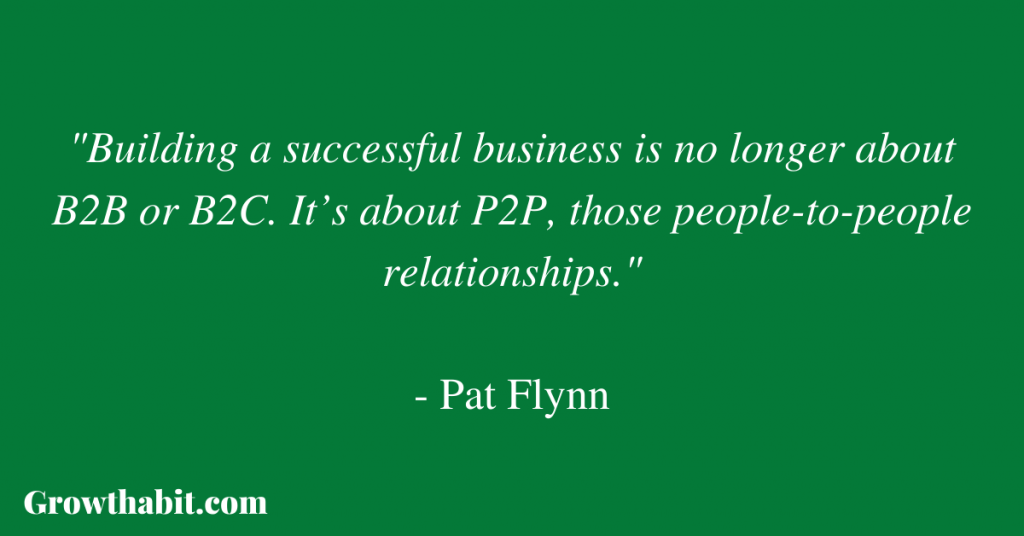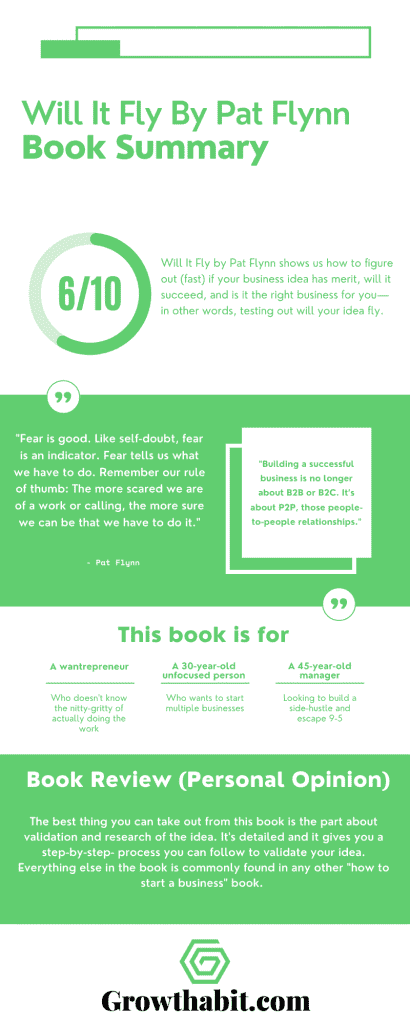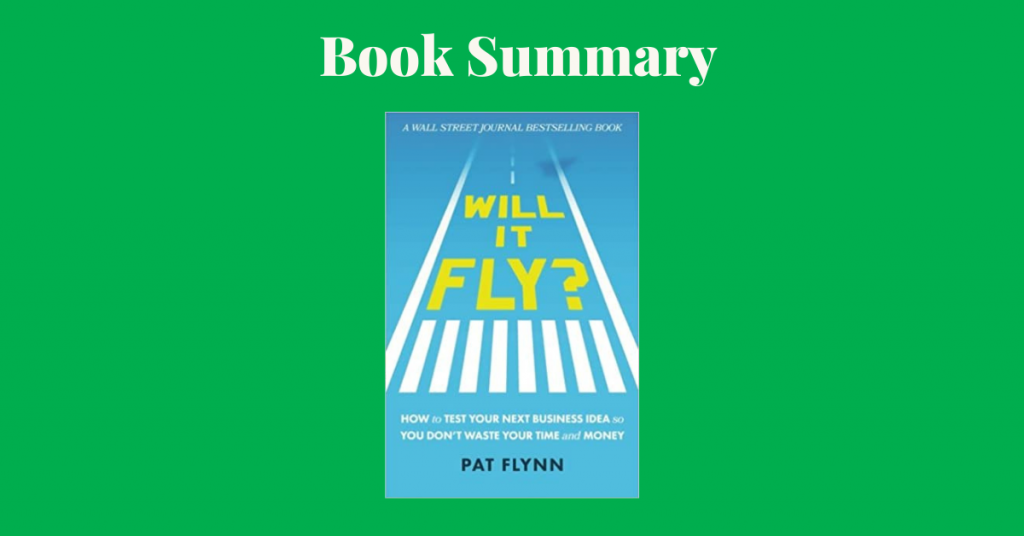Will It Fly by Pat Flynn shows us how to figure out (fast) if your business idea has merit, will it succeed, and is it the right business for you—in other words, testing out will your idea fly.
Book Title: Will It Fly?: How to Test Your Next Business Idea So You Don’t Waste Your Time and Money
Author: Pat Flynn
Date of Reading: September 2017
Rating: 6/10
What Is Being Said In Detail:
Will It Fly is divided into five sections:
- Mission Design
- Development Lab
- Flight Planning
- Flight Simulator
- All Systems Go
Mission Design helps you align your business idea with your goals in life. If you don’t care about it, don’t work on it.
Development Lab is about refining your target idea as much as possible through conversation and observation.
Flight Planning is about the current market conditions and the three P’s: places, people, and products.
Flight Simulator is about testing (and validating) the business idea on a small segment of the audience. You validate the idea when you actually ask people to buy— and they buy it.
All Systems Go is the final check-up to make sure your idea is ready to go—full speed ahead.
Most Important Keywords, Sentences, Quotes:
A common myth of startup is that it is all about an idea matched with execution. IDEA + EXECUTION = SUCCESS. The reality is that the missing factor is you (and your partners). YOU + IDEA + EXECUTION = SUCCESS.
In June of 2008, I was told I was going to be let go. After some mild depression and moving back home with my parents, I ended up turning my knowledge about the incredibly difficult LEED exam into an online business selling study guides, classes, and practice exams for this test. Within a year, GreenExamAcademy.com generated over $200,000 in sales. Since then, I’ve built several other businesses and have earned a total of over $3.5 million online.

We can assume outcomes one way or another, but until we put a method and data behind it to test those assumptions, we’re risking being pulled into something that seems right, but may prove to be completely wrong. Experimentation will illuminate the truth.
You cannot fail these tests, because it’s not you who is being tested. It is your ideas. No matter the outcome of the tests, it’s always going to be a win for you.
Although you might worry that you’re “late to the party,” the fact is that you have a great advantage over everyone else who is already there. You’ll get a big-picture look at how your target market is being served, what’s missing, or what opportunities exist. From there, you can favorably position yourself to win.
PART 1: MISSION DESIGN
“Building a successful business is no longer about B2B or B2C. It’s about P2P, those people-to people relationships.”
“Fear is good. Like self-doubt, fear is an indicator. Fear tells us what we have to do. Remember our rule of thumb: The more scared we are of a work or calling, the more sure we can be that we have to do it.”
What can you bring to the table that no one else can? What is your unfair advantage?
She describes an unfair advantage as a skill or asset that you have that no one else has, or very few others might have in a specific niche. It’s your competitive edge, and whatever that edge may be, it’s your job to use it to your advantage as much as possible as you shape and create your business.
PART 2: DEVELOPMENT LAB
“Whenever I ask you a question, Patrick—in an email, on the floor, or in my office—I want you to respond in just one sentence. That’s all you get. Think about what you need to say in one sentence that will convey all of the necessary items that will help me understand exactly what’s going on. One sentence. Nothing more. Do you understand?”
Because this is what happens when you start sharing that idea—it starts becoming refined. And a refined idea is a much more mature idea. You’ll get quick feedback—instant, guttural feedback from people—and especially from complete strangers that say ‘that is a stupid idea’ or ‘that’s a great idea but have you thought about this?’
“Nothing. But, here’s the difference between you and the next person on the street who has a great idea—if you’re committed and you love the idea, you will actually see it to completion. Most people never execute on their ideas because they just never execute. The reason I’m a success as an entrepreneur, and why many other entrepreneurs are a success is simply because we do it. We don’t just talk about it; we do it.
“What’s something I can add that even someone with experience inside this industry couldn’t do?”
With that said, one final word of caution: positive feedback is not 100% true validation that you’ve got a winning business on your hands.
PART 3: FLIGHT PLANNING
“Well, really, it’s not about the money, it’s about helping individual people. Like you said, it’s great to think worldly and big and create the next “spreadsheet,” but what I think you can do is niche down and change a smaller group of people’s world. Right? Taking a specific market and changing their world. Not necessarily creating a spreadsheet for everybody, but maybe a spreadsheet just for people who have 3-year-old kids who are potty training.
…what I try to teach is that you don’t have to go big in the world to experience success. You just have to be big in somebody’s world.
“Assume conservatively that your True Fans will each spend one day’s wages per year in support of what you do. That ‘one-day-wage’ is an average, because of course your truest fans will spend a lot more than that. Let’s peg that per diem each True Fan spends at $100 per year. If you have 1,000 fans that sums up to $100,000 per year, which minus some modest expenses, is a living for most folks.
Before we begin our research, I must warn you that you’ll likely to find other businesses or products that are similar to the one you’re developing. Don’t let that stop you. In the thousands of conversations and the surveys I’ve conducted with future entrepreneurs, the number two reason why people hesitate to get started is because they’ve found out that someone else has already taken their idea. The number one reason is the fear of failure.
“Different is better than better.”
Your Customer P.L.A.N. is broken down into four sections, in this specific order:
1. Problems
2. Language
3. Anecdotes
4. Needs
When you serve you get paid back in return, but only if you give those you serve a way to pay you back in some way, shape, or form.
The riches are in the niches, but the fortune is in the follow-up.
When you are starting a business, one of the most important things you can do is understand the language your target customer uses to communicate.
They are solutions to problems, often times a combination of stuff that already exist, made in a certain way that is more potent and effective than what’s out there already.
PART 4: FLIGHT SIMULATOR
“Intuition and experience are poor predictors of which products and businesses will be profitable…To get an accurate indicator of commercial viability, don’t ask people if they would buy—ask them to buy. The response to the second is the only one that matters.”
I didn’t know this at the time, but my mom was giving me a very important lesson in validation. What someone says they’re going to do, and what they actually end up doing can be completely different, so you need more than just words in order to count on them. Sorry, mom!
The second worst mistake that you can make is building your business based on someone’s word that it’s something they would buy or use. Like my mom taught me, what people say and what they end up doing can be completely different, and in the world of entrepreneurship, the following is what you need to know when it comes to what other people say:
Listen to others, but trust your numbers.
“The common model for building products is we have an idea…we go into our workshop to make it…we emerge back into civilization…we shout from the rooftops what we’ve made…we wait and hope we hit the mark and people actually give us money. And sometimes this can work. But sometimes it can lead to a huge flop that could have been prevented. By getting others involved early in the process, you can get actual feedback from real customers and build not what you think they want but what they actually want.”

For example, if your target market is fly fisherman, and you have a product specifically suited for beginners, not everyone who goes fly fishing will be interested in your particular solution. In order to properly validate your idea, you need to at least discover who the beginner fly fisherman is. Depending on what your idea is, you may need to narrow down your search even more. Let’s say your solution helps fisherman discover what their first set of gear should be. Well, then you need to find those who are not only beginners, but those who have yet to purchase their gear.
The reason I bring this up is because when I first started as an entrepreneur, I was deathly afraid to interact with people when I knew I was going to eventually ask for money. You’ve already learned how to talk to people about your idea, but adding the pitch element to it scares a lot of people, like it did to me.
Taking into account our research and the interaction we have with our prospects, the goal is to have 10% of those prospects take action with you ahead of the build. That means for every 10 people you pitch here in Step 4, you should try to get at least one person to pre-order or pay. The more interested prospects you speak to, the better, but 10% is a good standard to use here.
“I’d recommend people joining groups where their target audience and prospects live and getting involved. It’s not difficult; it just takes work. That’s where you start.”
You don’t need to spend a lot of money to start a business. With only 24 hours and $7.99, I got this biz going.
You don’t need to spend tons of money and time to validate a business.
PART 5: ALL SYSTEMS GO
And finally, although the entrepreneurial journey can be filled with many challenges and failures, make sure you enjoy the ride, too. This path has chosen you as much as you have chosen it.
Book Review (Personal Opinion):
The best thing you can take out from this book is the part about validation and research of the idea. It’s detailed and it gives you a step-by-step- process you can follow to validate your idea. Everything else in the book is commonly found in any other “how to start a business” book.
Rating: 6/10
This Book Is For (Recommend):
- A wantrepreneur who doesn’t know the nitty-gritty of actually doing the work
- A 30-year-old unfocused person who wants to start multiple businesses
- A 45-year-old manager looking to build a side-hustle and escape 9-5
If You Want To Learn More
Here’s a podcast episode of Pat Flynn talking about the book.
Pat Flynn on Entrepreneur’s Journey
How I’ve Implemented The Ideas From The Book
Before we started Growthabit, we did quite a lot of research to see if there’s even an opportunity to make a legit business out of helping people build reading habits. And, as you can probably guess, there is space for that. So we measured twice before we cut once.
One Small Actionable Step You Can Do
Ask people to buy something from you that you still haven’t built. It’s one of the scariest things you can do, but nothing validates (or crushes) an idea faster than that.

